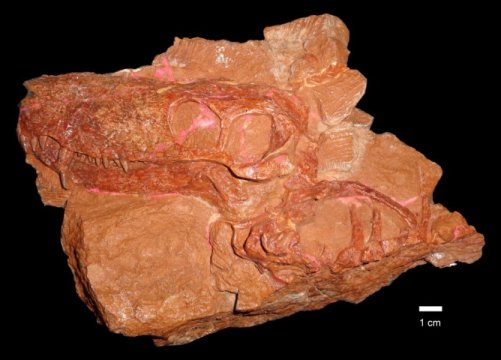[ad_1]
Fossils representing two new species of saber-toothed prehistoric predators have been described by researchers from the North Carolina Museum of Natural Sciences (Raleigh, USA) and the Vyatka Paleontological Museum (Kirov, Russia). These new species improve the scientists’ understanding of an important interval in the early evolution of mammals — a time, between mass extinctions, when the roles of certain carnivores changed drastically.
Living mammals are descended from a group of animals called therapsids, a diverse assemblage of “protomammals” that dominated terrestrial ecosystems in the Permian Period (~299-252 million years ago), millions of years before the earliest dinosaurs. These protomammals included tusked herbivores, burrowing insectivores, and saber-toothed predators. The vast majority of Permian therapsids have been found in the Karoo Basin of South Africa, and as a result, the South African record has played an outsized role influencing scientists’ understanding of protomammal evolution. Because of this, therapsid fossils from outside of South Africa are extremely important, allowing scientists to discern whether observed events in the protomammal fossil record represent global or merely regional patterns.
Recent expeditions by the Vyatka Paleontological Museum have collected a wealth of spectacularly-preserved Permian fossils near the town of Kotelnich along the Vyatka River in European Russia. These fossil discoveries include the remains of two previously unknown species of predatory protomammals, newly described in the journal PeerJ by Christian Kammerer of the North Carolina Museum of Natural Sciences and Vladimir Masyutin of the Vyatka Paleontological Museum. The first of the two new species, Gorynychus masyutinae, was a wolf-sized carnivore representing the largest predator in the Kotelnich fauna. The second new species, Nochnitsa geminidens, was a smaller, long-snouted carnivore with needle-like teeth. Gorynychus belongs to a subgroup of protomammals called therocephalians (“beast heads”), whereas Nochnitsa belongs to a different subgroup called gorgonopsians (“gorgon faces”).
Both new species are named after legendary monsters from Russian folklore, befitting their menacing appearances. Gorynychus is named after Zmey Gorynych, a three-headed dragon, and Nochnitsa is named after a malevolent nocturnal spirit. (Based on their relatively large eye sockets, it is likely that Nochnitsa and its relatives were nocturnal.)
Gorynychus and Nochnitsa improve scientists’ understanding of ecosystem reorganization after the mid-Permian extinction (260 mya). Although not as well-known as the more devastating end-Permian mass extinction (252 mya, which nearly wiped out protomammals), the mid-Permian mass extinction also played a major role in shaping the course of protomammal evolution. In typical late Permian ecosystems, the top predators were giant (tiger-sized), saber-toothed gorgonopsians and therocephalians were generally small insectivores. In mid-Permian ecosystems, by contrast, these roles are reversed. At Kotelnich, the saber-toothed top predator Gorynychus is a therocephalian and the only gorgonopsians are much smaller animals.
“In between these extinctions, there was a complete flip-flop in what roles these carnivores were playing in their ecosystems — as if bears suddenly became weasel-sized and weasels became bear-sized in their place,” says Kammerer. The new species from Russia provide the first evidence that there was a worldwide turnover in predators after the mid-Permian extinction, and not just a localized turnover in South Africa.
Kammerer adds, “Kotelnich is one of the most important localities worldwide for finding therapsid fossils — not only because they are amazingly complete and well-preserved there, but also because they provide an all-too-rare window into mammal ancestry in the Northern Hemisphere during the Permian.”
Story Source:
Materials provided by North Carolina Museum of Natural Sciences. Note: Content may be edited for style and length.
[ad_2]















